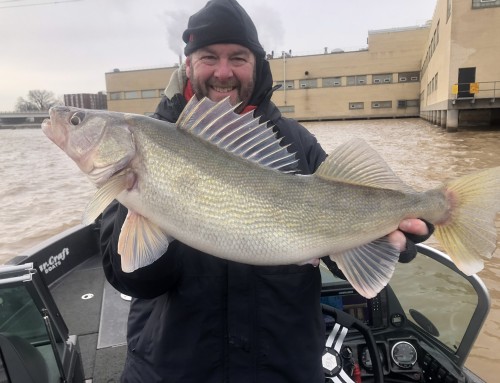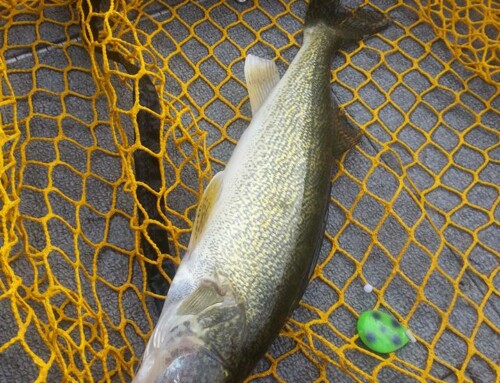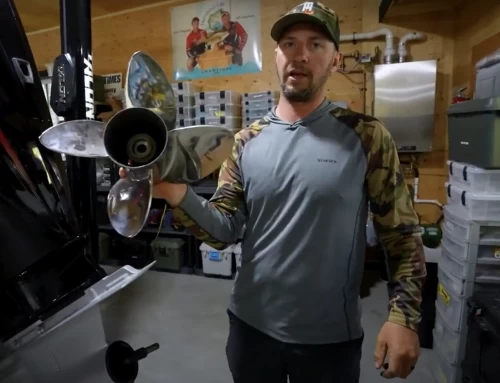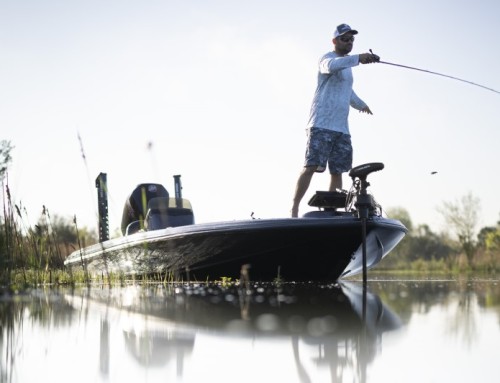Lake Winnebago is an incredible body of water with conditions dictating different methods of fishing on a daily basis, The system includes the Fox and Wolf rivers, Lake Poygan, Lake Buttes Mortes, Lake Winneconne and the main lake (137,708 acres). All totaled, it is approximately 200,000 acres of fishing experience.
Trolling has become a staple of fishing on this body of water. Typically in Late April many of the walleyes return from their spring spawning runs up the rivers. The walleye re-enter the main lake and spread out over the reefs and into the mud flats over the next month. Many times the ‘eyes will follow large baitfish schools around the system.
As these baitfish move through the system many of the walleye will relate only to the food source, rather than structure. Trolling becomes instrumental to allow fisherman to cover vast area of real estate in a quick and effective method.
The standard set up includes a line counting reel, a long 7+ foot rod, and 10 pound monofilament line. At the end of the mono, tie on a stainless steel barrel swivel to prevent twisting of the line. Make sure the swivel is small enough to pass through the guides on your pole. The swivel will also act as a weed catcher and will prevent some of the weeds from making a track all the way to the hooks of the crankbait.
On the other end of the swivel, tie on a 3 foot leader of 17 pound Vanish. This serves two purposes. Number one it is nearly invisible to the fish, and number two the heavier test will wear better should you encounter some sharp objects in the water like rocks or zebra mussels.
Lure selection on the Winnebago chain is an art in itself. Due to the heavy population of Sheephead and White bass, I always run a pearl white shad bait #5 on one of the lines regardless of cloud cover conditions. The Reef Runner baits have been a very successful lure line for me the last several years. Since the introduction of Flicker shads byBerkleyin 2006, this closely rivals the Reef Runner Rip shads for production on this body of water. Salmo Hornents have been on fire forthe last several years, especially in shallow water for big fish.
Typically, color selection is best determined by cloud cover; Bright colors (orange, purple, bubblegum) on bright days, natural colors (ie: black, gold, silver) on cloudy days. Try to always select a color combination which features a hint of orange on the belly of the lure when fishing walleye. Most of the walleyes diet is based on young perch and the orange is something they can hone in on.
Once the crank baits are ready to go, tip each with a quarter crawler on the front treble hook. Make sure the night crawler piece does not reach back to the 2nd treble hook as this will cause the lure to run incorrectly. By tipping the lure, you have created a natural bait scent in the water, and have encouraged the fish to strike the main body of the lure rather than nipping at the back of the lure increasing the hook up percentages.
No lure should ever be released in the water unless you have tuned it first. Check the running pattern of the lure at trolling speed to see if it has a knack of running left or right. A lure running out of tune, will cross other lines, and create havoc on your fishing excursion. To adjust the lure move the eyelet on the bait slightly in the direction you want the lure to run. Do this in small increments until the crank bait runs as desired.
The art of crank bait trolling has been around for years, and recently developments in understanding lure dive curves has made the job a little easier for fishermen. During the 1990’s Dr Steve Holt and Mark Romanack developed the Troller’s Bible called “Precision Trolling” which is now in its 8th edition. This book is a must have on every boat which uses trolling as a key method.
“Percision Trolling” allows anglers to examine dive curves of the most commonly used lures on the market. Understanding exactly where your lure will make its presentation in the water column is a key element to your success.
During set up, watch your electronics and take note at what depth the fish marks are occurring on your finder. Refer to your “bible’s curve chart” and determine the amount of line you will need to release to get the crank bait to the desired depth.
If you were not lucky enough to locate fish on the electronics prior to setting up, I suggest running lures at varied depths through the water column to locate fish. Make mental notes as to which pole is at which depth. Once a pattern is established, fine tuning the other rods is recommended. However, do not set all poles to one depth. Keep some higher and lower in the water column to cover more area.
Once the appropriate length of monofilament is released from your reel, attach your Off-Shore in-line planner board to the line. I personally love the tattle tail flags and quick release options which are add-ons to the orginial board. The tattle tail flags will detect light biters, or small fish, as the boards run through the water column. Depending on your tension setting, it can also detect when the line is fouled with weeds. The Snapper Adjustable Tension Planer Board Release (quick release flips) are much easier to handle while a fish is on the line then the standard squeeze planner board releases.
Based on wind conditions, use either your Mercury kicker or your trolling motor to get the lures moving. Mercury makes an incredible line of smaller motors which are ideal for this type of fishing. Using the kicker motor allows for more precise trolling speed with lower consumptions of fuel than your main motor. The pro kicker 9.9 hp comes with electronic start and tilt options, and can be driven off the main throttle system of your boat if it is equipped with this feature. Simply said, “sweet.”
Speed control is vital once the lures are in the water. On the Winnebago chain I usually start in the 1.5- 2.0 mph range in late spring and early summer. Remember, the slower you go, the longer it will take your lures to settle in at the final running depths. If you are getting hit early in the deployment, run your lures higher in the water column as the fish are staged toward the top of the water column. I always work the boat in “S-curves” to speed the lures on one side of the boat, and slow them on the opposite side. This gives multiple presentations on the same trolling pass. Notice which speed is producing the fish, and this indicates if the fish desire a faster or slower presentation. Do not be afraid to experiment with speed if you are not catching walleyes. At times a brisk 3.5 mphs has worked for me, especially when fish are in an aggressive mood.
Always try to get the boards out and away from the boat. The idea is to cover water while trolling, and having the boards too tight to the boat is counterproductive to what is trying to be accomplished. If possible try to stagger the board in a diagonal line away from the boat while setting up. This will help you read the boards, if you would have one suddenly fall back due to a fish on the line.
There is no better sight than a board which falls back hard. Even better when 3 or four boards drop back all at once. Get ready for some excitement.





